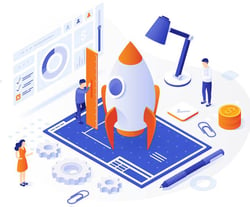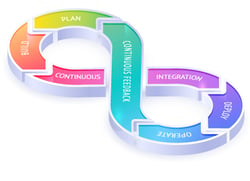 Developing a new product is a complex process that demands the cooperation of various product teams, the collection of resources, and a significant budget. But before development can begin, there needs to be a product plan and approval from senior executives.
Developing a new product is a complex process that demands the cooperation of various product teams, the collection of resources, and a significant budget. But before development can begin, there needs to be a product plan and approval from senior executives.
There are key differences in how product managers get approval, depending on the product development approach their company is following. In this article, we will address agile and stage-gate methodologies to understand better the different ways to gain approval for a product idea.
The Stage-Gate Method: Detailed Planning from the Start
The stage-gate approach requires comprehensive planning before any development begins, including all the steps required, costs, and projected revenues to justify the product. Product approval involves presenting a high-level business case to gauge executive interest and asking for the full budget upfront. Product approval in stage-gate is a high-stakes, important step to see your design come to life.
An Overview of Stage-Gate
 The stage-gate approach to product development traditionally comprises five distinct phases, with a gate or checkpoint between each phase. If the product successfully meets the criteria at the gate, it moves on to the next stage of development.
The stage-gate approach to product development traditionally comprises five distinct phases, with a gate or checkpoint between each phase. If the product successfully meets the criteria at the gate, it moves on to the next stage of development.
The product strategy develops in the first and second stages. The consumer pain points are identified through in-depth market research, and the product manager devises a solution to address them. During this phase, the product management team outlines the features and creates a detailed design and product plan. In phase two, these comprehensive plans are presented to company executives, outlining product strategy, development timeframe, and the complete budgetary requirements.
Building a Fully Fledged Prototype
With a detailed plan in place and approved, work on the product can commence. This work involves creating a prototype. With traditional stage-gate methodology, product teams build a fully-fledged. Creating a prototype can take several months or years, depending on the complexity of the product. Once the prototype is complete, product testing can begin.
The Drawbacks of Creating a Fully-Fledged Prototype
Although it may seem logical to create a complete prototype for stakeholders and potential customers to interact with, this approach has significant drawbacks and limitations.
Full prototypes are expensive and time-consuming to build, and iteration cycles are restricted. With a complete prototype, there is only a limited amount of time to test and enhance the product before it is released, which may result in a substandard final product.
Limited Opportunity to Pivot
Stage gate is a rigid process requiring a somewhat strict plan. While some minor changes can happen while testing the prototype, any major changes will seriously delay the product's launch, affecting its viability.
Offers Predictability
Despite the rigidity of the stage-gate process, it is fairly predictable. With detailed plans developed in the early phases, development teams know exactly what needs to be done and in what order to build the finished product. This structure helps to reduce uncertainty and ensures there are fewer surprises along the way.
Increases Profitability
 The phase gate process improves time-to-market performance for increased profitability. It quickly refines and develops innovative ideas and products, providing clear direction towards achieving market success. Faster product launches also lead to increased sales and profits.
The phase gate process improves time-to-market performance for increased profitability. It quickly refines and develops innovative ideas and products, providing clear direction towards achieving market success. Faster product launches also lead to increased sales and profits.
Offers Assurances Along the Way
The checkpoints between each phase offer the opportunity to formally review the work that has been completed and ensure that it conforms to the expected standards. Executives and product managers can also look ahead to determine whether the product should continue to the next stage.
Provides a Strategic Focus
The stage-gate approach is based on factual reviews to ensure that the right products are built. If the product doesn't meet a set list of criteria, then it won't align with the goals of the product or the company and will require more work. The point of the approval stages helps prevent serious misalignments from the start.
The Agile Planning Method: A Dynamic Approach
 The agile product development method offers a more dynamic approach where a lean business case is used for product idea approval. Rather than presenting a full business case and creating a full prototype for testing, the agile approach starts out small, building a minimum viable product (MVP), then testing, and then iterating to improve the product. The development happens in a more dynamic way while still using a roadmap to keep the development on target.
The agile product development method offers a more dynamic approach where a lean business case is used for product idea approval. Rather than presenting a full business case and creating a full prototype for testing, the agile approach starts out small, building a minimum viable product (MVP), then testing, and then iterating to improve the product. The development happens in a more dynamic way while still using a roadmap to keep the development on target.
Addressing the Immediate Needs of the Product
The agile method prioritizes immediate needs and avoids extensive upfront planning. Using this approach, the product manager explains the importance of the product, identifies the target demographic, presents market test results, and creates a roadmap with regular milestones for evaluation.
Breaking Down the Budget
Instead of outlining the entire product development process as part of a project, and seeking approval for the entire budget, the lean business case focuses on short-term goals and estimates for completing the product. For example, product management teams can present specific objectives, such as creating the MVP and Epics that can be a product or an iteration to test the viability of the product before the next iteration, and allocate short-term funding to meet those objectives.
To speed up execution and reduce idle time, instead of funding projects, in Agile frameworks, they prefer the creation of cross-functional teams that are delivering products or solutions continuously and the team will have a fixed recurring budget and is right sized in different intervals (maybe quarterly, or yearly). In effect bringing new ideas to the team as opposed to building the team around the project.
Cost Control and Decision Points
 Agile's lean business case also emphasizes cost control by allocating funds incrementally. The process of breaking down the product development into smaller manageable iterations ensures that funds are used efficiently and offers the flexibility to pivot or stop a project if initial reviews reveal problems. As a result, agile planning allows informed decision-making, preventing the overcommitment of resources early in the product development.
Agile's lean business case also emphasizes cost control by allocating funds incrementally. The process of breaking down the product development into smaller manageable iterations ensures that funds are used efficiently and offers the flexibility to pivot or stop a project if initial reviews reveal problems. As a result, agile planning allows informed decision-making, preventing the overcommitment of resources early in the product development.
The Iterative Approach to Building Products
The agile framework starts by building the MVP to showcase the product's unique selling points. Iterative testing cycles, consumer presentations, and feedback gathering lead to improvements before moving on to the next feature.
Continuous testing and iteration provide valuable insights, confirming the viability of the product vision and ensuring the correct product-market fit.
Encourages Adaptation and Flexibility
Agile product development is flexible and adaptable, allowing for changes as new insights arise. When using a product roadmap effectively, this approach also ensures alignment with the company's vision, even if that vision evolves over time.
Supports Strategic Investment
The budgetary approval process in agile allows the company to focus on immediate needs and outcomes and ensures resources are used efficiently and effectively. This approach also helps to reduce the financial risk to the business.
Product Roadmaps: An Essential Tool in Product Development
The choice of whether to implement agile or phase gate largely depends on the type of industry and product you are creating. Whichever process you choose, product roadmap management software can help you to reach your goals. Check out these resources for useful tips for product managers, and book a free demo to see how Gocious can work for you.


